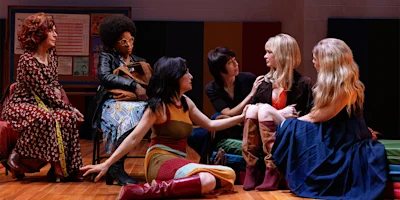
The real history behind 'Liberation' on Broadway
Bess Wohl's play, centered on a fictional feminist group in the '70s, is inspired by real "consciousness-raising" groups and movements for women's equality.
Summary
- The Broadway play Liberation follows a fictional group of women who start a feminist group in the '70s through the lens of the founder's daughter looking back on this history from the present day
- The story is inspired by the real history of consciousness-raising groups for women during the second-wave feminist movement
- Events like the 1970 Women’s Strike for Equality and the Women’s Liberation Movement inspire parts of the plot
The basement of an Ohio rec center in 1970 doesn’t seem like the typical setting for igniting societal change and dismantling inequitable norms. But in Bess Wohl’s Liberation, a group of women find community, empowerment, and collective activism when they meet there for a weekly consciousness-raising group. Liberation, now in performances at the James Earl Jones Theatre after an acclaimed off-Broadway run earlier this year, is also a memory play: The daughter of the group’s founder, Lizzie, is looking back at this moment in her now-deceased mother’s past.
Lizzie’s daughter questions why her mother eventually drew away from feminist activism and toward a more traditional, domestic life. As she tries to understand who her mother really was, she sees parallels emerge between the challenges women faced in the 1970s and today and questions how far we’ve come in the last 50 years.
With the suggestion that the personal is political, Liberation uses these fictional women to explore real feminist history, touching on the rights and protections that were hard-won in the past and which subsequent generations took for granted. Learn more about the history of consciousness-raising groups and the feminist movements that inspired Liberation below.
Get Liberation tickets now.
Consciousness-raising groups
A way to bring attention to social issues, consciousness-raising (C.R.) groups became an important part of the feminist movement in the late 1960s and throughout the 1970s, when Liberation is set. C.R. groups focus on various causes, but they are primarily associated with second-wave feminists.
C.R. groups gathered informally in a home or community center where women of different backgrounds could talk about their experiences. As Liberation demonstrates, these groups revealed patterns of oppression in women's houses, relationships, and workplaces, proving they were not alone in struggling with sexist societal expectations. For example, even though journalist Lizzie and secretary Dora are in different industries, both young professionals face misogyny and barriers to career opportunities in their offices.
Lizzie founds and promotes the C.R. group in Liberation, and she tends to be the de facto leader in the beginning despite believing that “hierarchy is patriarchy.” In theory, though, C.R. groups did not have leaders.

The waves of feminism
Historically, four waves of feminism have been recognized in the United States. Each wave built upon the previous one, and the current wave is inspired by the battles of the early 1970s explored in Liberation.
First-wave feminism
The first wave of feminism is generally considered to have begun with the Seneca Falls Convention in 1848 and ended in the early 1920s after the 19th Amendment was ratified, giving women the right to vote. Leaders of this movement included Elizabeth Cady Stanton, Susan B. Anthony, Alice Paul, and Ida B. Wells.
Second-wave feminism
Second-wave feminism was sparked by the publication of Betty Friedan’s book The Feminine Mystique and began as part of the larger social upheaval of the 1960s. Unlike first-wave feminism, this wave was focused on social and cultural equality, rather than political. In addition to Friedan, other leaders of this wave included Gloria Steinem and Audre Lorde.
The C.R. group in Liberation is in this wave of feminism. The members are influenced to different degrees by liberal feminism, which tries to change patriarchial systems and gender dynamics from within through legal measures, and radical feminism, which seeks to dismantle and rethink these systems entirely. Several Liberation characters explore the ideas of radical feminism, but among them, Susan most strongly champions radical beliefs.
Third-wave feminism
Third-wave feminism critiqued the limitations of earlier waves, striving for more intersectionality and diversity in the movement. A pivotal moment was Anita Hill’s 1991 testimony accusing Clarence Thomas of sexual harassment before a white, male Senate Judiciary Committee.
He was ultimately confirmed to the Supreme Court the following year, and Rebecca Walker published an essay in Ms. Magazine titled “Becoming the Third Wave,” encouraging readers to “[l]et Thomas' confirmation serve to remind you, as it did me, that the fight is far from over.”
The women in Liberation read Ms. Magazine, which Steinem founded in 1971, and Lizzie even ends up working there.
Fourth-wave feminism
Fourth-wave feminism is generally agreed to be our current wave. It is a feminism of the digital age, with social media harnessed to fuel activism; the #MeToo movement is an example. In addition to fighting against sexual harassment, unequal pay, and the rollback of reproductive rights, this wave includes advocacy for transgender rights and awareness that you don’t have to be a cisgendered woman to be a feminist.
Lizzie’s daughter lives in the present day, so, like the audience, she is experiencing fourth-wave feminism.

Women’s Liberation Movement
A defining part of second-wave feminism, the Women’s Liberation Movement challenged the patriarchy and its societal norms. Members of this movement fought for causes including reproductive rights (which led to Roe v. Wade), equality in the education sphere (which led to Title IX), and financial liberation (which led to women's ability to take out mortgages and possess credit cards in their name).
Although the Women’s Liberation Movement grew out of the civil rights movement and was inspired by the fight for racial justice, it focused primarily on the concerns of white intellectuals (with the exception of Audre Lorde) as opposed to struggles faced by women of color and working-class women.
Liberation reflects this dynamic as well, illustrating how the C.R. group is not actually as inclusive as intended. The character of Celeste, a college-educated editor visiting from New York, deals with being the Ohio group's only Black member. And Joanne, a Black working mom of four who encounters the group while looking for her son’s backpack, notes that “no normal woman with school-age children can join a group that meets consistently at 6 p.m. on a school night.”

The Equal Rights Act
For more than a century, feminists have been campaigning to pass the Equal Rights Act (E.R.A.), a constitutional amendment that would codify equal rights for women and men in the U.S. Constitution. Originally introduced by Alice Paul and the National Women’s Party in 1921, the bill was blocked dozens of times by Congress. While presidents on both sides of the aisle have voiced support for the E.R.A. over the years, it has never been enough to sway other powerful opponents.
After the nationwide Women’s Strike for Equality in 1970, which features in the plot of Liberation, the E.R.A. finally received enough votes to move through Congress. It then needed to be ratified by 75% of U.S. states within seven years. But when the deadline expired, the E.R.A. was three states short of the mark.
The amendment has been reintroduced in Congress almost every year since the original deadline expired. Several states have backed out over the years, and there is still not sufficient support among legislators to pass the E.R.A. It’s been more than half a century since the events of Liberation, but as Lizzie's daughter observes as she looks back from the present day, the fight for equality continues.
Get Liberation tickets now.
Photo credit: Liberation off Broadway. (Photos by Joan Marcus)
Frequently asked questions
What is Liberation on Broadway about?
Tony nominee Bess Wohl's Liberation tells two stories of family and feminism: of a young woman in the 1970s who starts a "consciousness raising" group in small-town Ohio, and of her daughter in the 2020s, who seeks answers about her mom's relationships with her onetime group members, her life before becoming a mother, and where their activism efforts went sideways.
How long is Liberation on Broadway?
The running time of Liberation on Broadway is 2hr 30min. Incl. 15min intermission.
Where is Liberation on Broadway playing?
Liberation on Broadway is playing at James Earl Jones Theatre. The theatre is located at 138 West 48th Street, New York, 10036.
How much do tickets cost for Liberation on Broadway?
Tickets for Liberation on Broadway start at $64.
How do you book tickets for Liberation on Broadway?
Book tickets for Liberation on Broadway on New York Theatre Guide.
Originally published on




